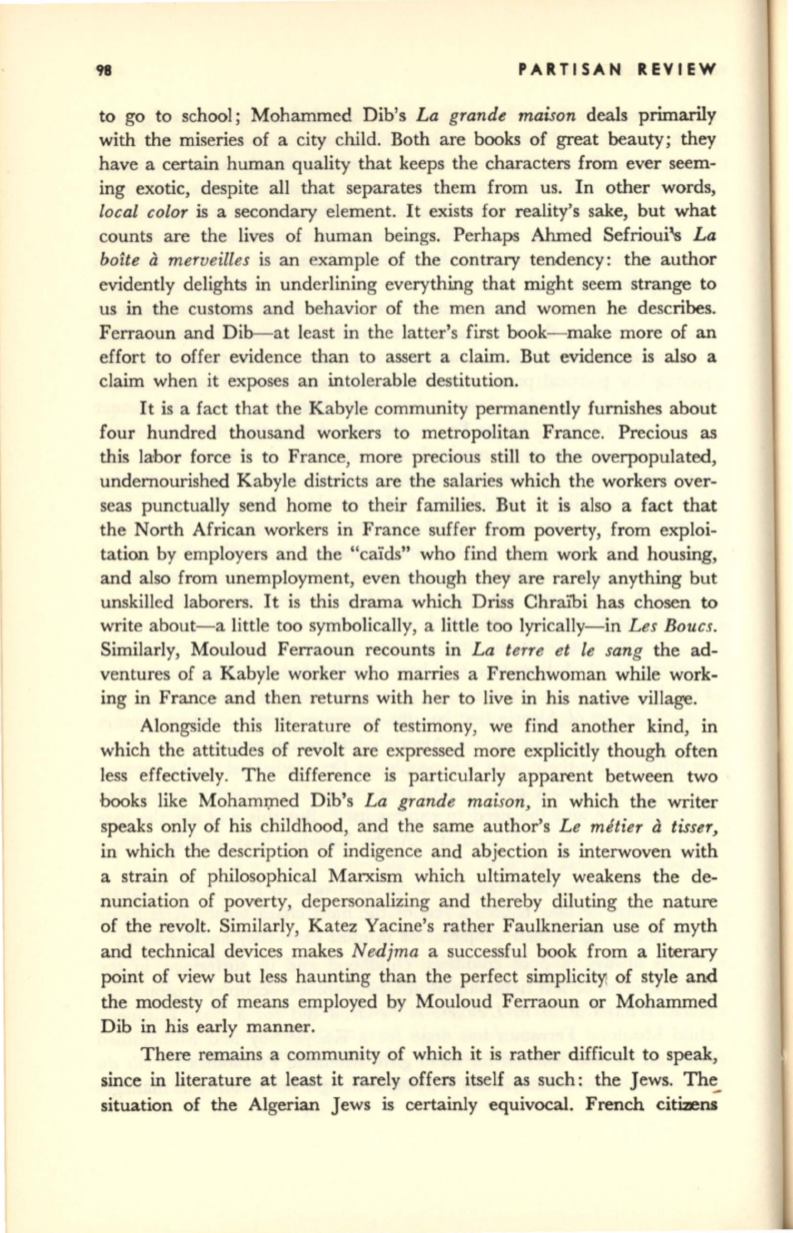
98
PARTISAN REVIEW
to go to school; Mohammed Dib's
La grande maison
deals primarily
with the miseries of a city child. Both are books of great beauty; they
have a certain human quality that keeps the characters from ever seem–
ing exotic, despite all that separates them from us. In other words,
local color
is a secondary element.
It
exists for reality's sake, but what
counts are the lives of human beings. Perhaps Ahmed Sefrioui\;
La
boite
a
merveilles
is an example of the contrary tendency: the author
evidently delights in underlining everything that might seem strange to
us in the customs and behavior of the men and women he describes.
Ferraoun and Dib-at least in the latter's first book-make more of an
effort to offer evidence than to assert a claim. But evidence
is
also a
claim when it exposes an intolerable destitution.
It is a fact that the Kabyle community permanently furnishes about
four hundred thousand workers to metropolitan France. Precious as
this labor force is to France, more precious still to the overpopulated,
undernourished Kabyle districts are the salaries which the workers over–
seas punctually send home to their families. But it is also a fact that
the North African workers in France suffer from poverty, from exploi–
tation by employers and the "cruds" who find them work and housing,
and also from unemployment, even though they are rarely anything but
unskilled laborers. It is this drama which Driss ChraJ.oi has chosen to
write about-a little too symbolically, a little too lyrically-in
Les Boucs.
Similarly, Mouloud Ferraoun recounts in
La terre et le sang
the ad–
ventures of a Kabyle worker who marries a Frenchwoman while work–
ing in France and then returns with her to live in his native village.
Alongside this literature of testimony, we find another kind, in
which the attitudes of revolt are expressed more explicitly though often
less effectively. The difference is particularly apparent between two
books like Mohaml)1ed Dib's
La grande maison,
in which the writer
speaks only of his childhood, and the same author's
Le metier
a
tisser,
in which the description of indigence and abjection is interwoven with
a strain of philosophical Marxism which ultimately weakens the de–
nunciation of poverty, depersonalizing and thereby diluting the nature
of the revolt. Similarly, Katez Yacine's rather Faulknerian use of myth
and technical devices makes
Nedjma
a successful book from a literary
point of view but less haunting than the perfect simplicity! of style and
the modesty of means employed by Mouloud Ferraoun or Mohammed
Dib in his early manner.
There remains a community of which it is rather difficult to speak,
since in literature at least it rarely offers itself as such: the Jews. Tht;..
situation of the Algerian Jews is certainly equivocal. French citizJens


